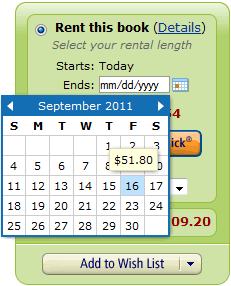Pssst, want to save a bundle on textbooks?
 That's the question raised by Amazon's new Kindle Textbook Rental service, announced today. Amazon claims 80-percent savings when renting rather than buying. Would you go for it?
That's the question raised by Amazon's new Kindle Textbook Rental service, announced today. Amazon claims 80-percent savings when renting rather than buying. Would you go for it?
Amazon says it has "tens of thousands" of e-textbooks available to rent for initial 30 day-periods with extensions that could go as little as one day more up to a total of 360 days. The rental program is available for Kindle ereaders or any device capable of running the Kindle software, including Android handsets or tablets, iPad, iPhone, Macs or PCs.
"Students tell us that they enjoy the low prices we offer on new and used print textbooks. Now we're excited to offer students an option to rent Kindle textbooks and only pay for the time they need", Dave Limp, Amazon's vice president for Kindle, says in a statement.
College textbooks are some of the most expensive pieces of disposable literature used today, which is perhaps one reason Amazon offers 70 percent for trade-ins and used items are in such high demand. Students typically spend as much as $200 for a book used for as much as four-and-a-half months. Adding workbooks and other textbooks, and semester textbook costs can easily top $1,000 or more.
Three days ago, my colleague Tim Conneally wrote about how "e-textbooks are destroying the old publishing business model". The analysis followed up a May deal where California State University agreed to purchase some e-textbooks from Nature Publishing. The first of the e-textbooks, "Principles of Biology" releases on September 1st.
Cal State opted for a direct deal with a publisher. Amazon discounts more represent its publisher relationships, which raises the question: Will there be selection actually required by major colleges and universities? There is another: What about online, interactive programs offered by publishers to supplement textbooks?
Betanews reader romath made an interesting point in comments to Tim's July 15th analysis: "In the article, I don't see anything about students being able to make notes in the margins, underline text and other things people do".
Good observation. Limp says Amazon has that covered. "We've done a little something extra we think students will enjoy. Normally, when you sell your print textbook at the end of the semester you lose all the margin notes and highlights you made as you were studying. We're extending our Whispersync technology so that you get to keep and access all of your notes and highlighted content in the Amazon Cloud, available anytime, anywhere -- even after a rental expires. If you choose to rent again or buy at a later time, your notes will be there just as you left them, perfectly Whispersynced".
That is a compelling feature, although without the e-textbook, some of the important context could be lost. Still, the feature shows just how other companies should be thinking about cloud computing, and it goes back to something I've been saying for years: Synchronization is the killer app for the connected age. Amazon gets it.
Yes, but don't students have to be able to find the books, which must actually be used in their course work? I ask because searching Amazon's text book store for "Introduction to Biology" and "Principles of Biology" yielded no rentals after quickly searching the first 40 books for each. So I haven't yet done a price comparison to see how close to 80 percent the savings might be for several textbooks.
Can you help me out? If you're a college student with curriculum for next year, please do your own Amazon search or simply type some of the titles and authors in comments so that I can do the search. I'm interested to see if there really are savings and if Amazon offers e-textbook rentals that real students need for their course work.
